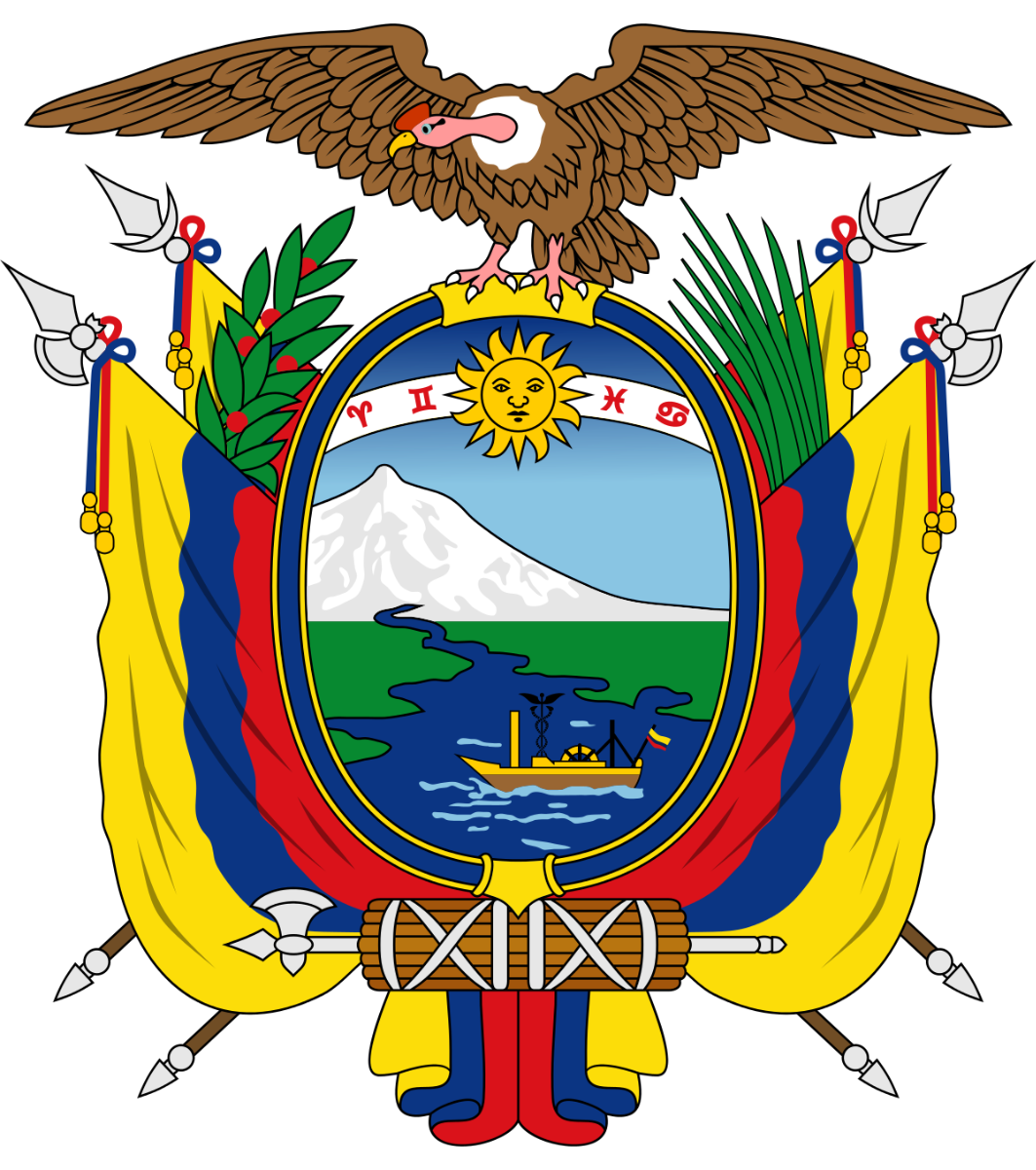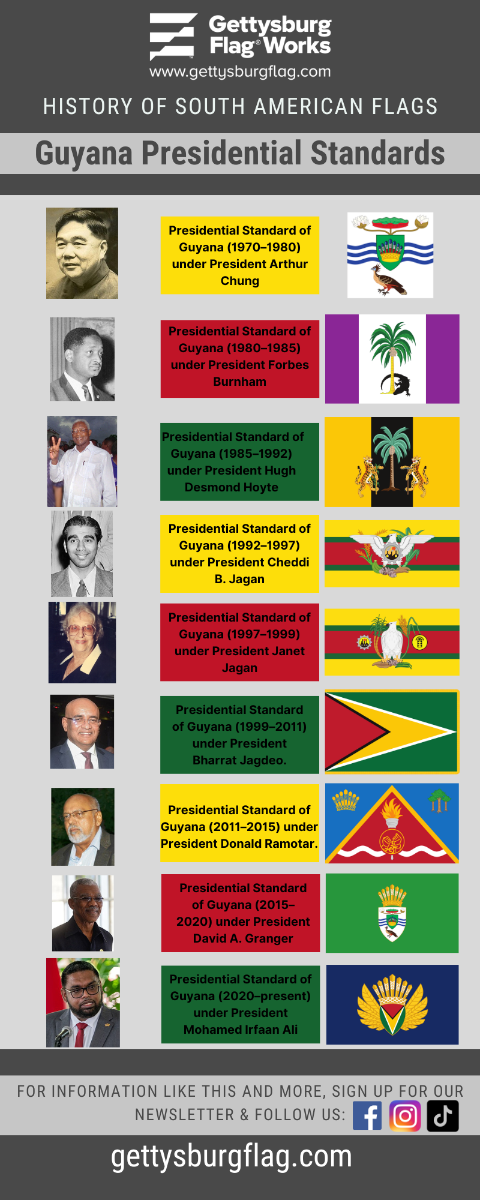Flags of South America
If you’re looking to embark on a colorful journey through the rich flag history of South America, then you’ve come to the right place. One cannot help but be captivated by the symbolism that is woven into the flags of each sovereign nation. From the towering Andes to the lush Amazon rainforest, the flags of South American countries stand as vibrant emblems, telling tales of independence struggle, national unity, and geographic identity. This article delves into the historical roots of each flag, exploring the unique narratives and cultural nuances that have shaped these symbols of national pride. From the ancient civilizations that once thrived on these lands to the modern republics that emerged, the flag designs of yesterday and today in South America serve as the perfect visual of the continent's diverse and dynamic history.

The Flag of Argentina
You might recognize this flag, or at least the vibrant colors from Lionel Messi and the rest of the Argentinian team that won the world cup in 2022 and has been a major contender on the world stage for a long time.
Argentina Flag Symbolism
The design features a three stripe white and blue color scheme and the current design has been in use since 1861. The original design was originally created in the Argentine war for independence around 1812. Those original flags named ”the flag of Manuel Belgrano” and ”the flag of Macha” were closely associated with war and the united provinces decided to add the sun of May in the flag following the revolution. The sun was already in use, as it was printed on coins at the time.
Cultural Significance
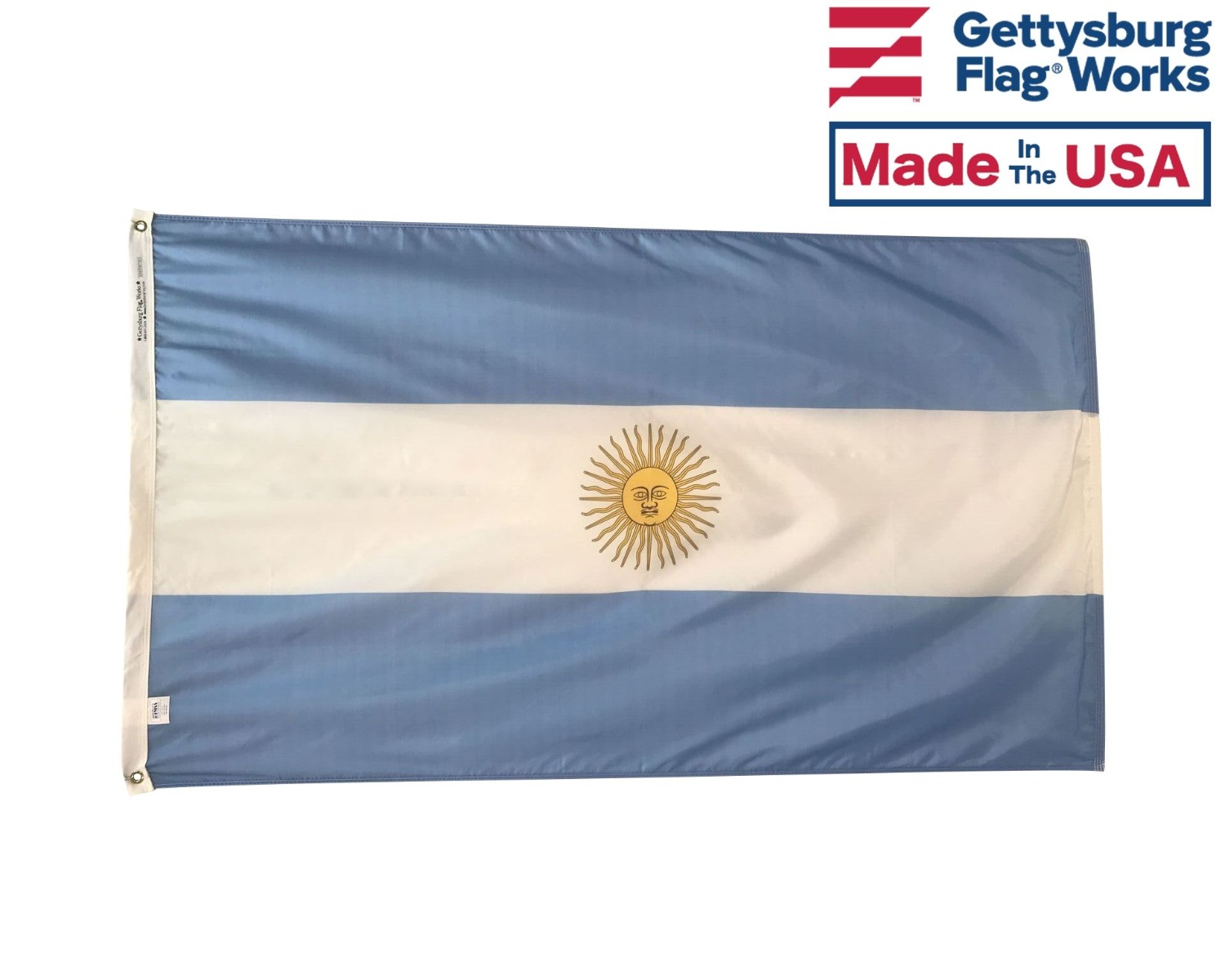
Many flags come out of revolution and turmoil. This is because they’re such strong representations of nationalism and new ideals. The colors of the Argentinian flag have changed over the years, but they eventually made their way back to the original blue and white color scheme that Manuel Belgrano chose in his original act of defiance towards the overruling Spanish monarchy at the time.
If you’re looking to sing the “Aurora” or get your Argentinian flag made in any style or historical version via a custom order, Gettysburg Flag Works is here for all your flag needs.
The Flag of Bolivia

At first glance, the Bolivian flag may seem basic. Having three colors with a seal on it is a common flag design many countries or areas utilize. It is a tri-colored flag with equally sized horizontal stripes. The colors have been named so specifically that the actual pantone color and hex numbers are available to make anything you have the correct shade of the selected color. This was finalized by the supreme decree of 2004.
Bolivian Flag Symbolism
The Red "represents the blood shed by our heroes for the birth and preservation of the Republic."
The Yellow "represents our wealth and resources" (referring to the natural land mineral deposits found in the country.
The Green "represents the richness of our natural areas as well as hope, a foundational value of our society" (referring to the fertility of the land in Bolivia).
Historically, there have been many different flags representing Bolivia due to different world powers claiming ownership of land and many ethnic groups that are indigenous to Bolivia and the surrounding countries.
Historical Bolivian Flags
Previous flags of Bolivia are the Colonial flag of the Spanish Empire which was present in Peru, and Bolivia from 1506–1825 and 1821 respectively. This flag is a great representation of how flags have evolved in South America over time.
Meaning Through Flag Color
Another interesting flag that we can custom make here at Gettysburg Flag is the beautiful Wiphala banner that is used to this day to represent the indigenous people of the Andes mountains. This flag still serves as a cultural representation for the people of the Andes today. The use of the colorful square sections allows for a vast amount of symbolism and has influences from generations of Andean people woven into the fabric.
The squares with the color Red signify the Earth (or pacha) and embody the intellect and cosmic philosophy of the Andean people. Orange represents society, culture, conservation, and the continuation of the human species, encompassing health, medicine, and youth education. Yellow expresses energy, strength, moral principles, and the doctrine of duality, including Pachakama and Pachamama, reflecting laws like brotherhood and human solidarity.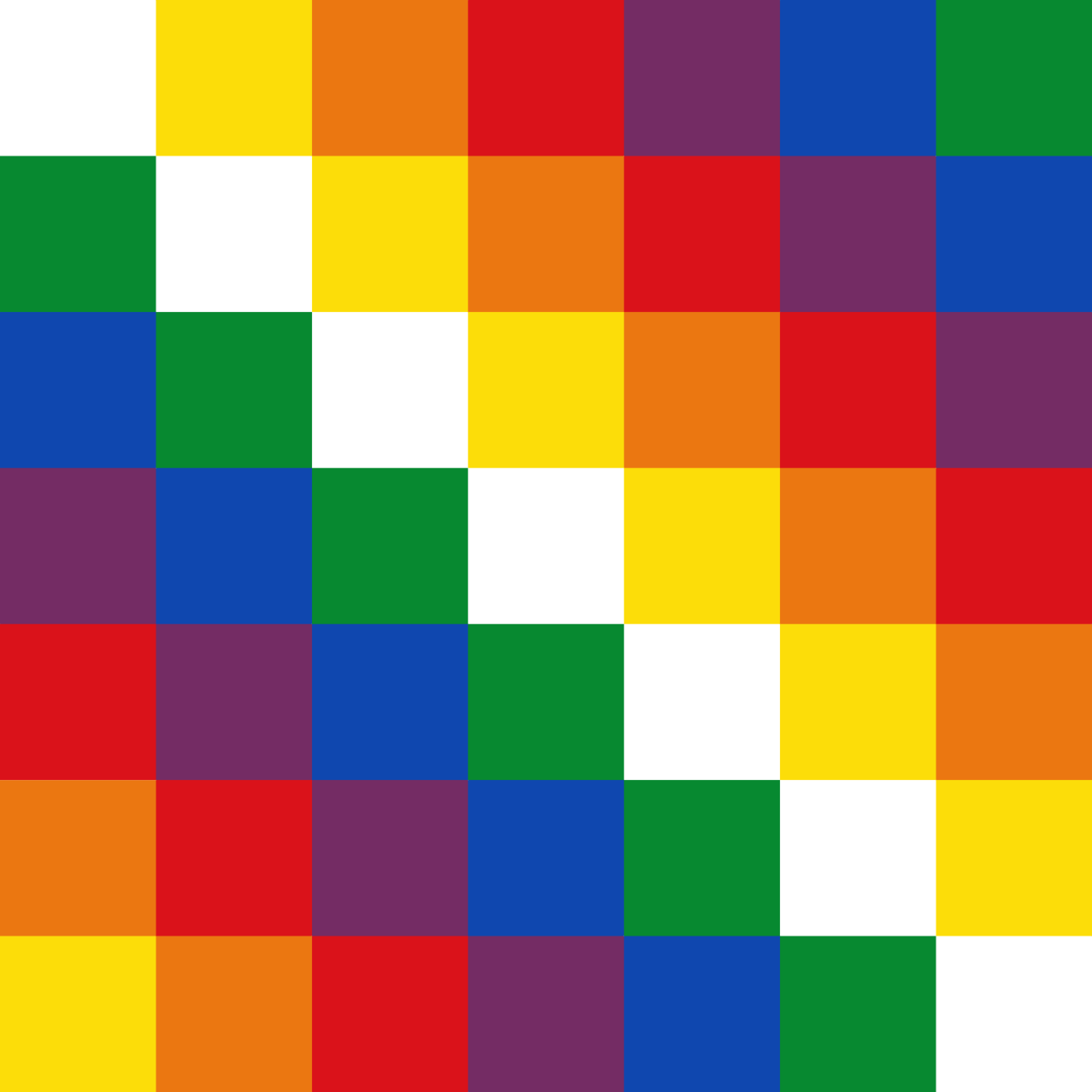 White symbolizes time, dialectics (Jaya Pacha), scientific and technological development, as well as intellectual and manual work fostering reciprocity and harmony within the community structure. Green, the color of hope, signifies the economy and production in the Andes, encompassing natural resources, flora, and fauna. Blue represents cosmic space, the infinite (araxa pacha), reflecting star systems and natural phenomena. Lastly, violet symbolizes harmony and represents Andean politics and ideology, emphasizing the sound administration of the state and various organizations for the overall benefit of society.
White symbolizes time, dialectics (Jaya Pacha), scientific and technological development, as well as intellectual and manual work fostering reciprocity and harmony within the community structure. Green, the color of hope, signifies the economy and production in the Andes, encompassing natural resources, flora, and fauna. Blue represents cosmic space, the infinite (araxa pacha), reflecting star systems and natural phenomena. Lastly, violet symbolizes harmony and represents Andean politics and ideology, emphasizing the sound administration of the state and various organizations for the overall benefit of society.
The Wiphala banner is truly a flag you need to see yourself to believe it! If you're interested in any Bolivian flags of the cultural flags of the area that span over many of the Andean people, Gettysburg Flag Works knows exactly what to do. With over 30 years of experience making custom flag creations, we will make it perfect for you, guaranteed!
The Flag of Brazil
Arguably the most distinct and unique South American flag, Brazil’s blue disc with a starry sky sits inside of a yellow rhombus and green background. Inside the disc spans their national motto “Order and Progress”.
Meaning Behind The Brazilian Flag
That may be more common knowledge as far as the flag design goes, but the symbolism behind those flag designs are pretty interesting as well. The green and yellow fields represent the first emperor of Brazil and his wife. The stars that are spread across the blue disc also have an interesting background because it is a depiction of the stars that were out on the night of November 15th, 1889.
Brazilian Flag History
Over time Brazil has been colonized by the Portuguese and had adopted the flag of the United Kingdom of Portugal, Brazil and the Algarves. Then, in 1822 the first Independent Kingdom of Brazil was established and three flags were used throughout that 50 year time period. Each of these flags were very similar to the last. The most current era of Brazil is the Republic of Brazil which still stands tall today. There have been 5 flag variations in this time starting with the provisional flag of the Republic of the United States of Brazil, going all the way to the current Brazilian flag.
The Flag of Chile
Another great and complicated history of flags occurs in Chile! We love discovering the history of the flags we offer and can even make the historical versions of current flags for the history buffs and anybody else that wants one!
Flag of Chile Symbolism
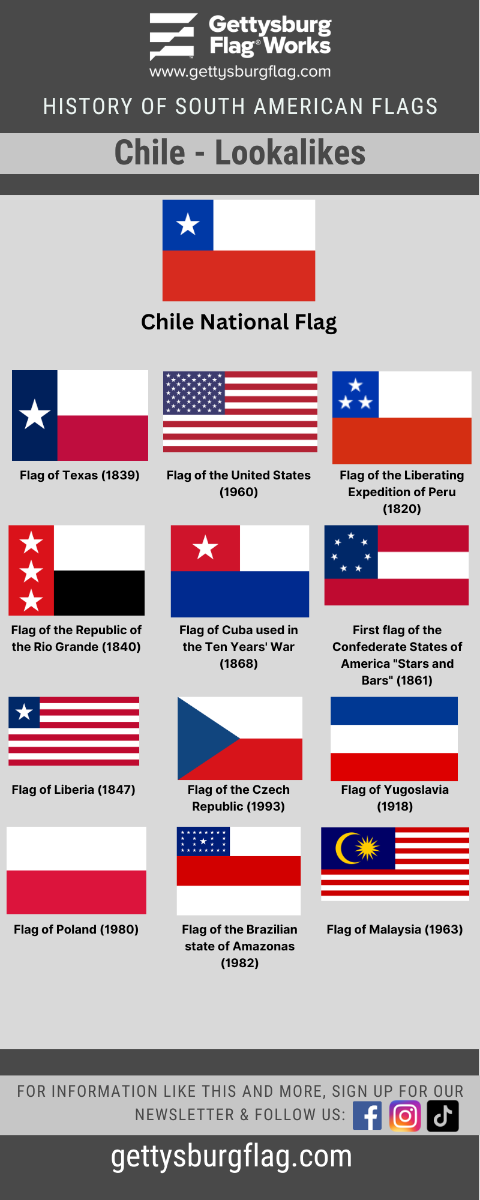
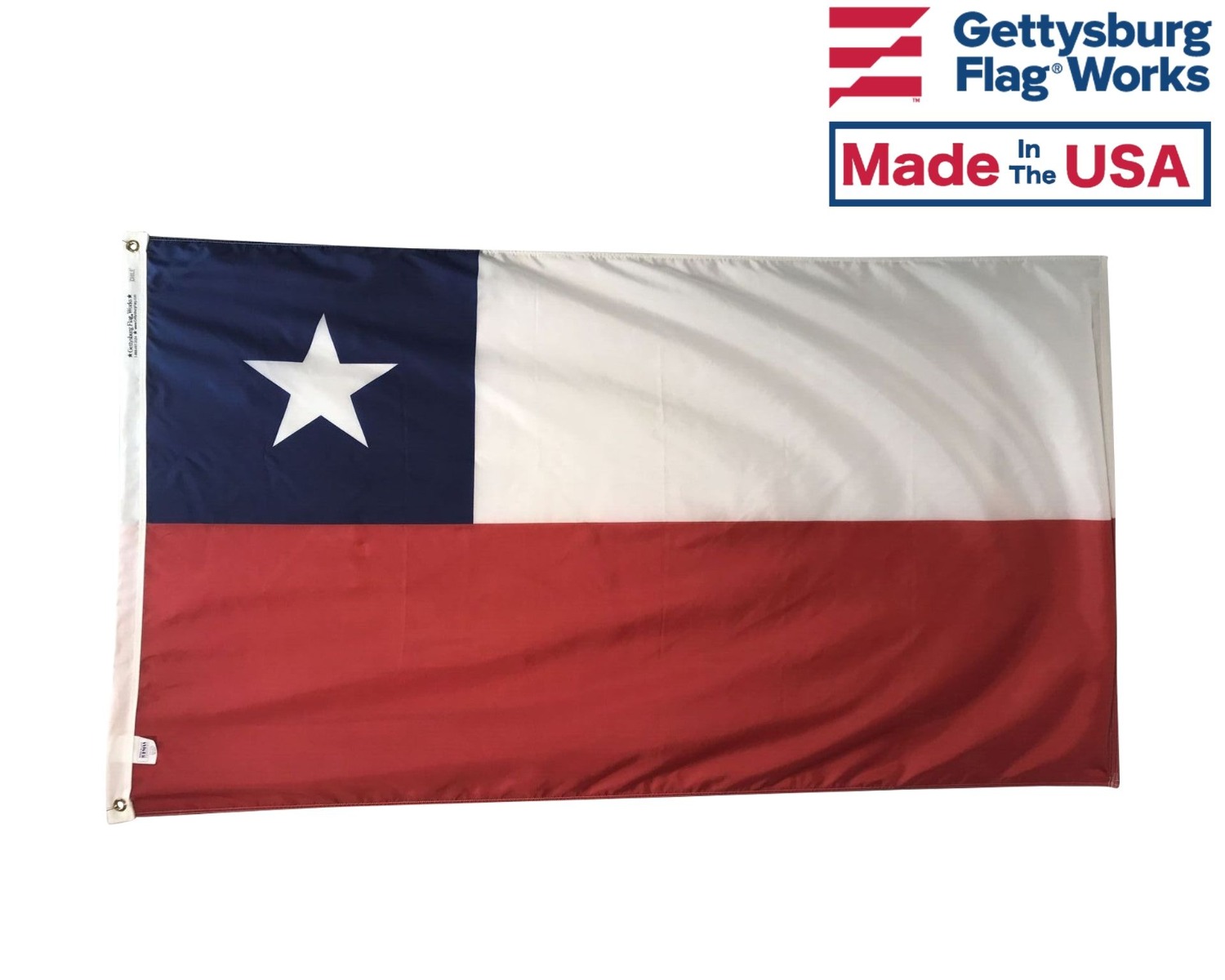
The current flag of Chile has two halves consisting of two horizontal stripes of white and red with a blue square in the upper left corner of the flag. Lastly, the canton holds a symbolic 5 point star that helps give it the Spanish name that many people know it by, La Estrella Solitaria or The Lone Star, in English.
If you’re from Chile, you’ll know that the star represents Venus and is very important to the indigenous people of Chile known as the Mapuches. The other colors are said to represent the blue sky and pacific ocean Chile holds so near and dear, the white and snow covered andes mountains that run along the country from north to south, and the blood sacrificed to reach an independent state.
Historical Chilean Flags
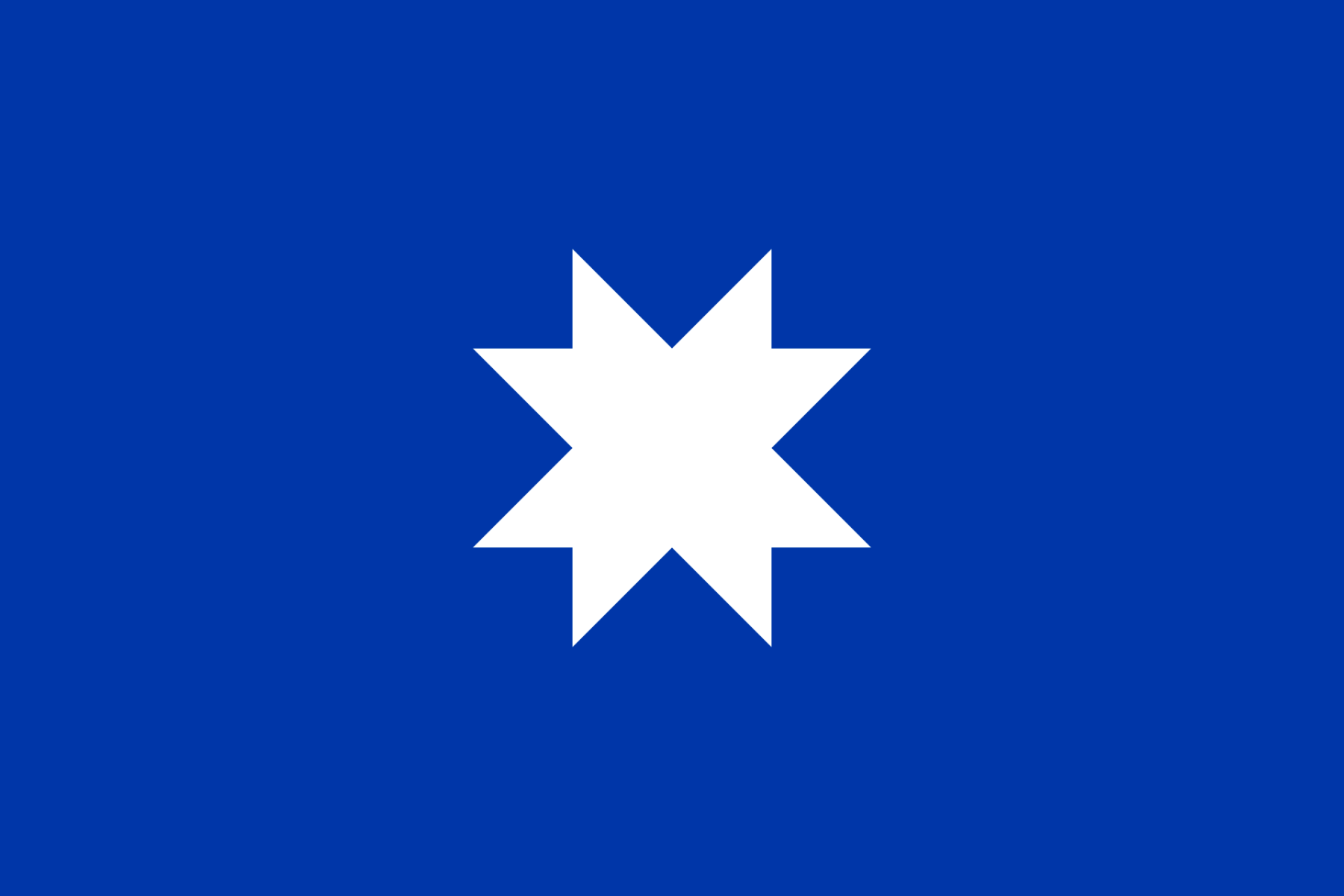
Before independence there were many flags that people used during wars and to represent their own interests and cultural beliefs. These include, the Guñelve which is also known as the star of Arauca. This flag is important because Bernardo O'Higgins modeled the current flag’s star after the star of Arauca, as it is the main inspiration for the lone star.
Spanish Influence on Flags
Many Spanish colonizing flags were created and used over time with each battalion having a different flag incorporating heraldic elements inspired by the coat of arms of the king of Spain.
The beginning of the independence effort marked the start of a new flag era for Chile. The first flag was titled the Flag of the Patria Vieja and was first developed in 1812. Its name in English translates to ”old fatherland” and it had three stripes that laid horizontally in blue, white and yellow. There is a bit of controversy over the true meaning of the colors on this first flag. Some claim that it is for the three branches of government: majesty popular, and law + force. It is also thought to represent features of nature: the sky, the snowy Andes and fields of golden wheat. Either way, there is a real sense of nationalism and it started the country off strong at the beginning of their independence.
A New Flag Era Brought Confusion
A new era named the Patria Nueva (New Fatherland) began in 1817 after the Battle of Chacabuco on May 26th. That day, a new flag was developed by Juan Gregorio de Las Heras with a small and meaningful change from the former color yellow to a red on the bottom stripe. The white and blue stripes would remain the same, but the red would now be able to “represent the blood that had been shed during the many conflicts. The issue with this flag was that it was often misunderstood to be the Netherlands or French flag. This made it so the flag was quickly abandoned less than a year after its creation.
The final and current Chilean flag has a bit of a legend to go along with it! It is said that it won a "Most Beautiful National Flag in the World" contest in the 19th century. Whether it’s true or not, there is a lot of symbolism and history wrapped into this flag. You can get the current Chilean flag here and you can get any other historical version of the flag made as a custom order here!
The Flag of Colombia
The Colombian people have had many flags throughout their history as the country has shifted through different times and many different national identity's. The land that is not Colombia was once a part of New Granada and shifted between the yellow green and red design to the yellow blue and red design at the creation of the flag of Gran Colombia in 1819. This history has had a significant influence on the evolution of the flag design. Ever since then, the stripes have shifted from horizontal to vertical designs and back again, as well as containing a seal/coat of arms, star patterns or nothing at all.
Eventually, the current flag of the United States of Colombia was created and enacted in 1861 and stands today under the current republic of Colombia. It is a rather unique flag due to the fact that one color (yellow) owns half of the flag while the other two stripes make up a quarter each.
Many historical and military flags have been used over the years and any of them can be made by our expert seamstresses. We can make anything from the Naval ensign of Colombia to the Presidential flag of Colombia.
The Flag of Ecuador
You may notice a couple of other South American flags that look similar to the Ecuadorian flag. Along with Ecuador, Colombia and Venezuela helped make up the former Gran Colombia. Design trends in the South American flags are evident due to the geographic proximity they all share. The distinguishing design factor is the coat of arms in the middle of the flag. There is an oval shield that acts somewhat like a picture frame for the mountain Chimborazo, which is the tallest mountain in the country. Another interesting fact about the coat of arms is the steamboat placed in the river which represents the first seaworthy steamship built in 1841 on Ecuadorian soil. It was also the first to be built in South America.
Other interesting flag detail about the coat of arms are the astrological signs that represent their march revolution, the condor, to show power and willingness to strike along with many other objects that are spread across the emblem like easter eggs in a movie.
An interesting flag fact about Ecuador is that it is one of only four countries that has a depiction of its own flag on the flag itself.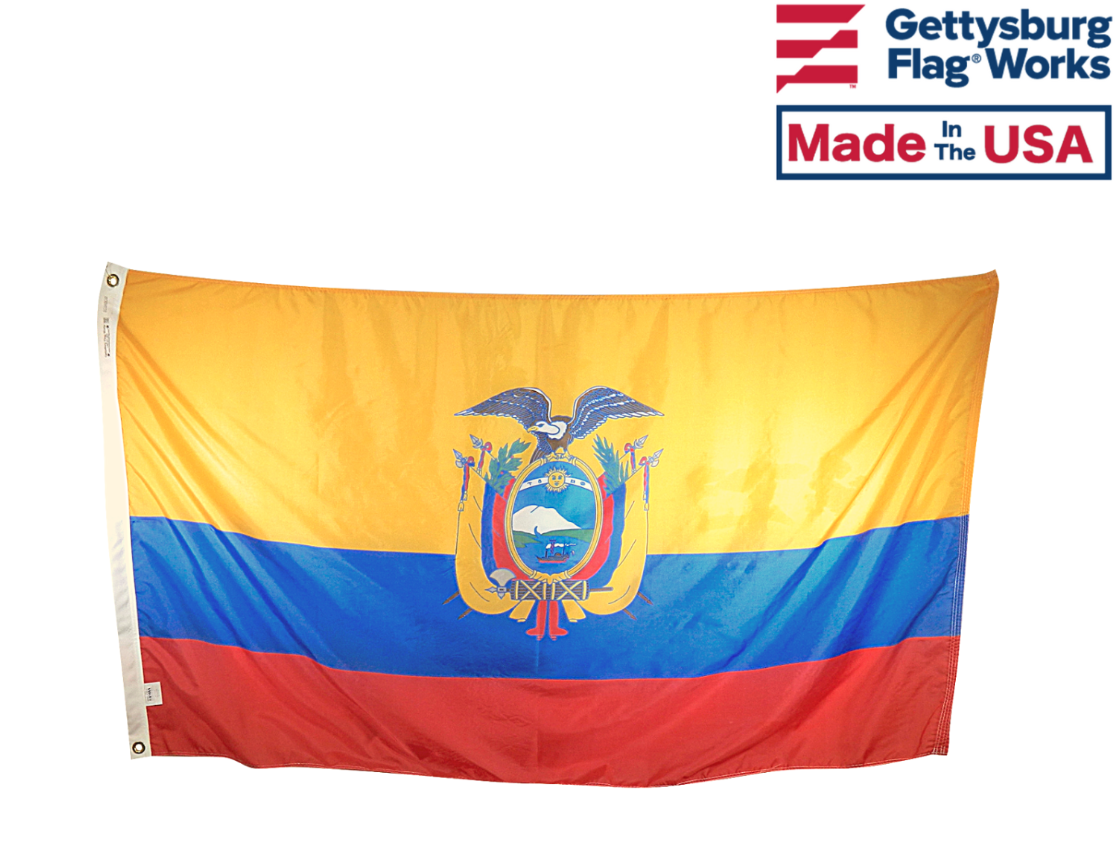 If you look closely, it is in the coat of arms emblem that is in the middle of the flag. There are many features that make this flag one of a kind and that is why it is a privilege to make them for you here at Gettysburg Flag. Whether you want the current Ecuador flag or the very first national flag, with five horizontal stripes and three stars across the middle stripe, we have what you need.
If you look closely, it is in the coat of arms emblem that is in the middle of the flag. There are many features that make this flag one of a kind and that is why it is a privilege to make them for you here at Gettysburg Flag. Whether you want the current Ecuador flag or the very first national flag, with five horizontal stripes and three stars across the middle stripe, we have what you need.
The Flag of Guyana
Now coined as the Golden Arrowhead, the national flag of Guyana has a lot of hidden meaning that you may not be aware of. Even if you are from Guyana, you may not know what all of the colors and shapes represent or where the design comes from.
While in school at Harvard an American named Whitney Smith designed the proposal for the flag of Guyana. He later went on to actually coin the term vexillology, which is the “scholarly analysis of all aspects of flags.”
The colors used in the flag are symbolic for many aspects of the land that makes up Guyana. The red represents zeal and dynamism, the gold is for their immense mineral wealth, the large green area represents the forest and great agriculture available in Guyana. Additionally, the black and white lines represent the endurance and rivers/water that the country has.
Each President that has been elected in Guyana has been able to proclaim a presidential standard flag to represent their presidency. This is a symbolic gesture and doesn't happen in every country, but in Guyana there have been 10 presidents that have created standards for the country. They range in design dramatically and are very interesting to break down. Check out the infographic to the right for all the Ecuadorian Presidential Standards (as of 2023)
If you would like to make any of these flags, Gettysburg Flag Works has an incredible staff that can create any flag in numerous print options.
The Flag of Paraguay
The flag of Paraguay is designed in a red, white and blue triband which is similar to the Netherlands tricolor flag. The most unique feature on the Paraguay flag is the fact that both sides are actually different. They have the same colors, but on the front side, the national coat of arms is found in the center. On the reverse side, the seal of the treasury sits in the middle of the flag. This is an extremely unique feature and is only seen on 2 other national flags in the world. Those countries are Moldova and Saudi Arabia.
Another very interesting flag fact in Paraguay is that every department has a special flag. Departments are akin to states or provinces in other countries like the U.S.A. As far as the evolution of the national flag goes, there are historical flags from the colonial era like the flag of colonial Paraguay from 1700 to 1785. There are also many variations of the national flag starting all the way back in 1811!
The Flag of Peru
The triband red and white striped flag of Peru has seen many variations since the colonial days of Spanish led Peru. In 1820 the struggle for independence was in full swing and a British born general who fought in many of the South American revolutions raised the first known flag that was not Spanish. It was a navy blue flag with the sun in the center to represent the Inca sun god called Inti.
This flag’s life was short-lived as soon after, the first flag was officially made to represent the Republic of Peru. This flag was diagonally quartered and made from red and white. The origin of the color selection is somewhat debated. One account says that the creator, General José de San Martín, was inspired by the flamingos he saw when he first arrived in Peru. Other accounts say that the colors were taken from other South American flags because San Martin was inspired by their deeper meaning.
In 1822 the flag changed and began to take a look similar to the Argentinian flag. At the time, this was quite reasonable due to how difficult it was to create the previous flag with a more complicated pattern and symbol.
Over the next couple of decades, a few variations of the flag were made. These changes were mainly due to the changing hands of power, the creation of the Peru-Bolivian Confederation, and changing back to the republic of Peru in the year 1839.
The final iteration of the Peruvian flag occurred in 1950 thanks to President Odria. Outlined above, it is the simple vertical three striped red and white flag that you can get right here at Gettysburg Flag Works. Even if you’re looking for an original Peruvian flag… we have you covered!
The Flag of Suriname
Suriname’s flag history differs slightly from the norm in South America. Most of the countries in South America were once colonized by Spain or Portugal, but Suriname was a small pocket of Dutch colonialism, and therefore has some different influences.
The current flag was adopted in November of 1975 after the finality of the independence struggle from the Netherlands was complete. The colors on this flag are green, white, red and yellow. Some of the meaning behind the colors are similar to other countries on the region. For example, the green, outer rows represent the “fertility of the land” that many of the South American countries possess. A couple other colors take on new meanings compared to the other countries. The red stands for progress while the yellow star in the center represents the golden future that they hope to have moving forward.
A national competition was the way the government decided to create their new flag. This was a unique way to get nationalism stirring at the turn of an era shifting from colonial power to a new nation. Along with the new flag, the country also needed a new coat of arms, as they were using the Amsterdam coat of arms as their own at the time. This changed and became a symbol of their indigenous population, the history of slavery and various influences that make the nation what it is today.
Suriname is also a country that uses presidential standards with each leader. If you’re looking for any of the Dutch colonial flags, standards of the government in their nation's history, or the classic Suriname country flag, we have you covered at Gettysburg Flag Works.
The Flag of Uruguay
You may recognize this national flag as it is similar in style and color to a couple of other South American flags. What you may not know is that it is only one of three flags that is used by the nation. The other two important national flags are the flag of Artigas and the flag of the Treinta y Tres.
The flag consists of 9 alternating white and blue stripes that symbolize the original departments of Uruguay. This is based on the 13 stripes that the U.S. uses to represent the original colonies before gaining independence and creating the United States.
The Sun of May is used to represent the sun god known as Inti. It appears in many flags throughout South American history but currently is only used in the flag of Argentina and the coat of arms of Bolivia.
Throughout its history Spanish, Brazilian and Portuguese rule over Uruguay has changed and adapted its flag. Additionally there have been a few flags such as the flag of the oriental state of Uruguay and the two variants that were used during the Uruguayan civil war.
Uruguay has had a fascinating history and it can all be captured through the country's flags. If you would like the current Uruguay flag or any of the historical Uruguay flags made for your collection or to fly proud on your own pole, just send us a message or call us today!
The Flag of Venezuela
Don’t confuse the Venezuelan flag with that of Colombia. On a map, the two countries sit next to each other on the north west corner of South America. They also share some overlapping history, but have very distinct nationalism and separate problems at the same time.
The colors on the current Venezuelan flag are bright and represent the wealth of the land, courage, and independence from Spain. Another way of thinking about the colors are to see the “golden America separated from bloody Spain by the deep blue sea”
The national flag has been through an incredible amount of shifts and changes. Most of the changes have to do with the number of stars present on the blue stripe, the inclusion of a seal or coat of arms, and the organization of the stars pattern.
Show your Venezuelan pride with your choice of any style flag from the long history of Venezuela from Gettysburg Flag Works!
South American Flags: Unique Histories, Unique Designs
Unique stories are found everywhere in the world. A complex history can be so difficult to encapsulate in a small piece of writing. That’s why it is so astonishing a flag can tell such a story with few or no words at all. All the color choices, emblems and shapes are specifically selected to show the nationalism and pride that people have for their homeland.
It is so important to us that people have access to the stories and flags that represent their countries and the histories that shaped them. That’s why we strive to supply you with any flag you could possibly imagine.
Whether you're interested in a South American flag, or you're in the market for another type of flag, be sure to check out our custom portfolios, or reach out to us with a design that you're interested in creating. Have questions? Give us a call at 1-888-697-3524 or contact us online and we'd be happy to assist!







